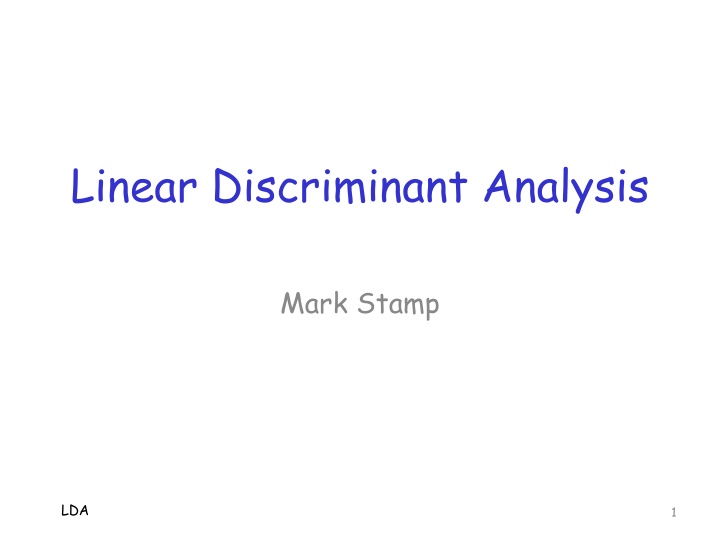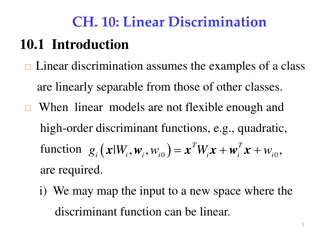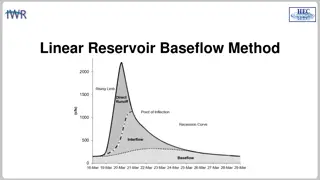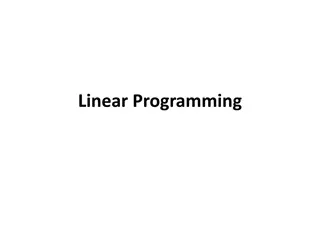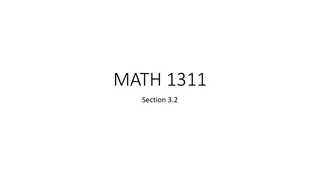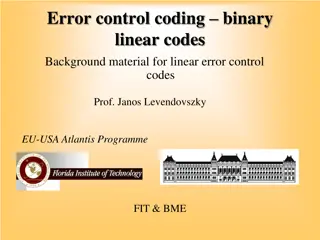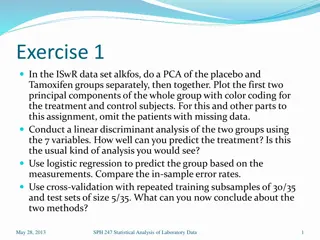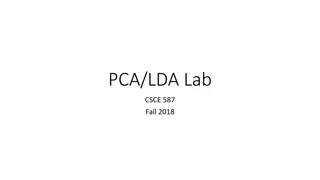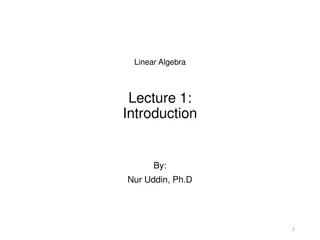Linear Discriminant Analysis
Linear Discriminant Analysis (LDA) and Quadratic Discriminant Analysis (QDA) are powerful techniques in machine learning for separating data based on labeled information. LDA uses a linear hyperplane, while QDA employs a quadratic surface for classification. This method is easy to visualize in 2D, making it a valuable tool for data analysis and pattern recognition applications. Simplify your understanding of LDA and its benefits in various contexts with informative illustrations and comparisons to other algorithms like Support Vector Machines (SVM) and Principal Component Analysis (PCA).
Download Presentation

Please find below an Image/Link to download the presentation.
The content on the website is provided AS IS for your information and personal use only. It may not be sold, licensed, or shared on other websites without obtaining consent from the author.If you encounter any issues during the download, it is possible that the publisher has removed the file from their server.
You are allowed to download the files provided on this website for personal or commercial use, subject to the condition that they are used lawfully. All files are the property of their respective owners.
The content on the website is provided AS IS for your information and personal use only. It may not be sold, licensed, or shared on other websites without obtaining consent from the author.
E N D
Presentation Transcript
Linear Discriminant Analysis Mark Stamp LDA 1
LDA and QDA Linear discriminant analysis (LDA) and quadratic discriminant analysis (QDA) o For both, the basic concept is simple Based on labeled data, separate match from nomatch region o In LDA, using a (linear) hyperplane o In QDA, use a quadratic surface Easy to visualize in 2-d LDA 2
LDA vs QDA In 2-d, separate with line vs parabola LDA 3
LDA vs QDA LDA is simpler, fewer parameters o Deep connections to both SVM and PCA o No kernel trick, and projection of data is simpler in LDA as compared to SVM QDA more complex, more parameters o Can separate some cases that LDA cannot o Very simple form of nonlinearity as compared to kernel trick used in SVM We ll only consider LDA here LDA 4
LDA and PCA and SVM (Oh My!) Can view LDA training similar to PCA o Training set consists of m experiments with n measurements each o Form a covariance-like matrix LDA training also related to SVM o We project/separate based on hyperplane o But, no kernel trick, so LDA is simpler Lagrange multipliers & eigenvectors? LDA 5
Big Idea Behind LDA? Scatter is closely related to variance Mean and scatter of training data is not under our control o But, have some control in projection space Project training data onto hyperplane... o Making distance between class means LARGE and the within class scatter small But how? LDA 6
LDA and Clustering Again, want projected data to have o Between-class means that are far apart o Within-class scatter is small (both classes) Recall that in clustering, we want... o Distance between clusters to be large o And each cluster should be compact o Replace cluster with class in LDA So, LDA is related to clustering too! LDA 7
Projection Examples Projecting onto hyperplane Why is projection (b) better than (a)? LDA 8
LDA Projection Again, in LDA we maximize separation between means and minimize scatter o In the projection space, not input space But, why worry about the scatter? That is, why not just separate means? o Almost like the opposite of K-means May be easier if we forget the scatter o What could possibly go wrong? LDA 9
LDA Projection In (a), means more widely separated But in (b), much smaller scatter LDA 10
LDA Training Want to account for both within-class cohesion and between-class separation o Cohesion is scatter in projection space o Separation based on projected means LDA uses a fairly simple approach o One expression that is a function of both cohesion and separation But first, we need some notation LDA 11
Notation Let X1,X2, ,Xmand Y1,Y2,...,Ynbe training vectors of 2 classes Each vector is of length l (Scalar) projection of X is Where vector w is to be determined LDA 12
Mean and Scatter Class means are o Note x and y are vectors And class scatter defined as o Note sx2 and sy2 are scalars, not vectors Next, want to compute projected means and scatter LDA 13
Projected Mean and Scatter Mean of X in projection space o And similarly for projected mean of Y Scatter of X in projection space o And similarly for projected scatter of Y LDA 14
Projected Means Consider the function o argmax M(w) is w that has largest distance between projected means Consider the function o argmin C(w) is w with smallest scatter o argmax 1/C(w) is same as argmin C(w) LDA 15
Fisher Discriminant In general o argmax M(w) argmax 1/C(w) So, how (or what) to optimize ? In LDA, we ll keep it simple Then argmax J(w) is desired solution Function J(w) is Fisher Discriminant LDA 16
Fisher Discriminant Why maximize Fisher Discriminant? Combines both large separation and small scatter in one simple formula Have we seen anything similar before? Reminiscent of silhouette coefficient LDA 17
Example Which has larger Fisher Discriminant? Why? LDA 18
Maximizing J(w) Expanding, we have o Note J(w) defined in projection space Game plan o Write J(w) in matrix form o Then maximize resulting matrix function o Then relate result to other methods LDA 19
Matrix Form Define within-class scatter matrices o Essentially, covariance matrices of X and Y o Total within-class scatter: SW = Sx + Sy Between-class scatter: These matrices all defined in input space, not in projection space LDA 20
In Projection Space But J(w) defined in projection space All of matrices on previous slide have analog in projection space o As above, use for projection space Define analog of SB as Can be shown that Define then LDA 21
Matrix Form In matrix form, Let s maximize! o Note that if vector w = argmax J(w) then w also works, for any scalar o So, let s require w to satisfy wTSWw = 1 The problem can now be stated as o Maximize: wTSBw o Subject to: wTSWw = 1 LDA 22
Lagrange Multipliers The problem can now be stated as o Maximize: wTSBw o Subject to: wTSWw = 1 Lagrangian is o L(w, ) = wTSBw + (wTSWw 1) How to solve? Partial derivatives, set equal to 0 LDA 23
Lagrange Multipliers Equivalent version of the problem is o Minimize: - wTSBw o Subject to: wTSWw = In this form, Lagrangian is o L(w, ) = - wTSBw + (wTSWw 1) Take derivatives wrt w, we find o - SBw + SWw = 0 o Or SBw = SWw LDA 24
Lagrange Multipliers Solution w to LDA training problem satisfies SBw = SWw Now, suppose the inverse SW-1exists, and define S = SW-1 SB Then desired solution w satisfies o Sw = w We see that w is an eigenvector of S o And Lagrange multiplier is its eigenvalue LDA 25
LDA and PCA and SVM Previous slide shows (deep) connection between LDA, PCA, and SVM o That is, Lagrange multipliers (SVM) and eigenvectors (PCA) arise in LDA training And it gets even better o Recall, Sw = w where S = SW-1 SB o Want between-class scatter large (SB) and within-class scatter small (SW-1 large) o So, must be largest eigenvalue of S LDA 26
Comparison of LDA and PCA In PCA, we determine score based on large variances LDA distinguishes between classes based on means and variances So, LDA does well if means separated o LDA will not do so well if means are too close, even if variances are distinguishing o Of course, underlying LDA and PCA problems are different LDA 27
Numerical Example Given the labeled training data Want to train LDA o That is, find projection vector w o So that J(w) is max o We ll solve based on Sw = w LDA 28
Mean and Scatter Matrices For given training data, means are Scatter matrices LDA 29
Matrices From previous slide, we find And we find So that LDA 30
Eigenvectors We find and Eigenvectors of S are o Eigenvalues 1=0.8256 and 2=0.0002 LDA 31
Solution? We have Just for fun, let s project training data onto each of w1 and w2 Slope of w1 is o m1 = 0.7826/0.6225 = 1.2572 Slope of w2 is o m2 = -0.4961/0.8683 = -0.5713 LDA 32
Projecting Onto Eigenvectors Comparing eigenvectors w1 and w2 LDA 33
LDA Project onto largest eigenvector of S gives best possible result for J(w) Easy to generalize LDA to more than 2 classes o Vector w replaced by a matrix W, each column of which determines a hyperplane o These hyperplanes partition the space for classification LDA 34
Bottom Line LDA is useful in its own right Also interesting because of many connections to other ML techniques o PCA, SVM, clustering, other? o Relates Lagrangian to eigenvectors LDA generalizes to more classes o QDA is another a generalization of LDA Nice! LDA 35
